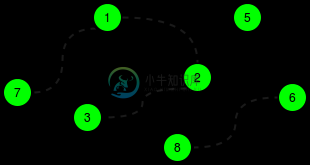竞争编码问题。无向图的BFS。获得WA
我正在Hackerrank上实现图形算法。
问题陈述:
HackerLand的统治者认为该国的每个公民都应该可以访问图书馆。不幸的是,HackerLand被龙卷风袭击,摧毁了所有图书馆并阻碍了道路!由于您是HackerLand最伟大的程序员,统治者希望您帮助修复道路并有效地建造一些新图书馆。
HackerLand有n个城市,编号从1到n。这些城市由m条双向道路连接。如果:
- 他们的城市有一个图书馆。
- 他们可以通过公路从他们的城市到一个有图书馆的城市。
下图是HackerLand的示例地图,其中虚线表示受阻的道路:

我的方法是:我用给定的城市和道路绘制一个图,其中每个城市表示图中的一个节点,每条道路表示一条边。我使用BFS算法来查找图的连通分量。然后在每个构件中创建一个库,并构建最少数量的道路,以便构件保持连接。
回答:
至少重新返回两次。
- 在每个组件中制作一个库的成本修复道路,以便每个组件具有最少数量的道路。
- 在每个城市建立一个图书馆。
在上面的例子中,修建一条道路的成本是2美元(c_road=2),而建造一个图书馆的成本是3(c_lib=3)。
在这里,这个图有两个组成部分: 1,2,3,7(所需道路为3)5,6,8(所需道路为2)
在每个组件中建立一个库的成本(2*3=6)修建所需道路的成本是(5*2=10)=16
在每个节点中建立一个库的成本是(7*3=21)=21
因此,答案是16。
我的代码:
注意:此程序中使用的基于1的图形索引。
#include<bits/stdc++.h>
using namespace std;
class Graph{
int v; // number of vertices
vector<int>*adj;
public:
Graph(int V){
this->v=V+1;
this->adj=new vector<int>[this->v];
}
void addEdge(int u,int v,bool biDir=true){
adj[u].push_back(v);
if(biDir)
adj[v].push_back(u);
}
void bfs(int ar[]){
// create a array of boolean to keep track of visited nodes.
int numComponent=0,numEdge=0;
bool visited[this->v];
for(int i=1;i<this->v;i++)
visited[i]=false;
// for each node in graph
for(int i=1;i<this->v;i++){
if(!visited[i]){
numComponent++;
numEdge+=bfsUtill(i,visited);
}
}
ar[0]=numComponent;
ar[1]=numEdge;
}
int bfsUtill(int src, bool visited[]){
// make a queue and insert src into it
int numEdge=0;
queue<int>q;
q.push(src); // insert src into queue
// mark first node as visited
visited[src]=true;
while(!q.empty()){
int node=q.front();
// visit
cout<<node<<" ";
// remove this node from queue
q.pop();
// visit every node adjacent to node 'node'
// if that node not visited then visit and enque it.
for(int adjNode:adj[node]){
if(!visited[adjNode]){
numEdge++;
visited[adjNode]=true;
q.push(adjNode);
}
}
}
return numEdge;
}
};
// Complete the roadsAndLibraries function below.
long roadsAndLibraries(int n, int c_lib, int c_road, vector<vector<int>> cities) {
// if c_road is greater than c_lib then
if (c_road>c_lib){
return n*c_lib;
}
Graph g(n);
// make graph of given vertices
for(auto x:cities)
g.addEdge(x[0],x[1]);
// Array to store number of component and number of edges need to be repaired
int ar[2];
g.bfs(ar);
long long int libInEach=n*c_lib;
long long int roadAlso= ar[0]*c_lib+(ar[1]*c_road);
return min(libInEach,roadAlso);
}
// driver code
int main(){
int t,n,m,c_lib,c_road;
vector<vector<int>>cities;
vector<int>temp;
cin>>t;
while(t--){
cin>>n,m,c_lib,c_road;
int a,b;
for(int i=0;i<m;i++){
cin>>a>>b;
temp.push_back(a,b);
cities.push_back(temp);
temp.erase();
}
cout<<roadsAndLibraries(n,c_lib,c_road,cities);
}
return 0;
}
我得到了一些测试用例的正确答案和一些测试用例的不正确答案。
我只发布了所需的代码,嵌入了整个程序。输入被传递到这个函数路和库()。
我测试助手函数,这些都工作正常。
-bfs()
-bfsU()
测试用例:
2
3 3 2 1
1 2
3 1
2 3
6 6 2 5
1 3
3 4
2 4
1 2
2 3
5
此测试用例的输出:
4
12
共有1个答案
我编辑了你的代码。这可能适用于您在hackerrank上的测试用例。这在给定的测试用例上运行良好。在任何组件中,如果顶点总数为n,则可以表示相同连接组件的最小边数为n-1。
#include<bits/stdc++.h>
using namespace std;
class Graph{
int v; // number of vertices
vector<int>*adj;
public:
Graph(int V){
this->v=V+1;
this->adj=new vector<int>[this->v];
}
void addEdge(int u,int v,bool biDir=true){
adj[u].push_back(v);
if(biDir)
adj[v].push_back(u);
}
void bfs(int ar[]){
// create a array of boolean to keep track of visited nodes.
int numComponent=0,numEdge=0;
bool visited[this->v];
for(int i=1;i<this->v;i++)
visited[i]=false;
// for each node in graph
for(int i=1;i<this->v;i++){
if(!visited[i]){
numComponent++;
numEdge+=bfsUtill(i,visited);
}
}
ar[0]=numComponent;
ar[1]=numEdge;
}
int bfsUtill(int src, bool visited[]){
// make a queue and insert src into it
int numEdge=1;
queue<int>q;
q.push(src); // insert src into queue
// mark first node as visited
visited[src]=true;
while(!q.empty()){
int node=q.front();
// visit
cout<<node<<" ";
// remove this node from queue
q.pop();
// visit every node adjacent to node 'node'
// if that node not visited then visit and enque it.
for(int adjNode:adj[node]){
if(!visited[adjNode]){
numEdge++;
visited[adjNode]=true;
q.push(adjNode);
}
}
}
return numEdge-1;
}
};
// Complete the roadsAndLibraries function below.
long roadsAndLibraries(int n, int c_lib, int c_road, vector<vector<int>> cities) {
// if c_road is greater than c_lib then
if (c_road>c_lib){
return n*c_lib;
}
Graph g(n);
// make graph of given vertices
for(auto x:cities)
g.addEdge(x[0],x[1]);
// Array to store number of component and number of edges need to be repaired
int ar[2];
g.bfs(ar);
long long int libInEach=n*c_lib;
long long int roadAlso= ar[0]*c_lib+(ar[1]*c_road);
return min(libInEach,roadAlso);
}
// driver code
int main(){
int t,n,m,c_lib,c_road;
vector<vector<int>>cities;
vector<int>temp;
cin>>t;
while(t--){
cin>>n,m,c_lib,c_road;
int a,b;
for(int i=0;i<m;i++){
cin>>a>>b;
temp.push_back(a,b);
cities.push_back(temp);
temp.erase();
}
cout<<roadsAndLibraries(n,c_lib,c_road,cities);
}
return 0;
}
-
问题内容: 我在Google App Engine中遇到争用问题,并尝试了解发生了什么。 我有一个注释为的请求处理程序: ..并且在该代码中,我获取了一些东西,更新了其他东西,等等。但是有时在请求期间日志中会出现这样的错误: ..之后是堆栈跟踪。如果需要,我可以使用整个堆栈跟踪进行更新,但这有点长。 我不明白为什么会这样。查看我的代码行中的异常,我在一个完全不同的实体(Round)上运行。错误消息
-
问题内容: (注意:这是针对MS SQL Server的) 假设您有一个具有主键标识列和CODE列的表ABC。我们希望此处的每一行都有一个唯一的,顺序生成的代码(基于一些典型的校验位公式)。 假设您有另一个仅具有一行的表DEF,该表存储下一个可用的CODE(想象一个简单的自动编号)。 我知道像下面这样的逻辑将呈现一种竞争状态,其中两个用户可能最终得到相同的CODE: 我知道,两个用户可能会卡在步骤
-
先让我把问题贴上。 这个问题是基于一个(几乎)真实的故事。一个无名的孩子有一大堆干净的袜子。这一堆包含了m双有图片和图案的袜子和n只纯白的袜子。每双袜子由两只相同的袜子组成,每一双都是独一无二的--没有两双看起来是一样的。所有纯白的袜子都是一样的。每天,孩子们从袜子堆里随机挑选两只,穿上,然后去上学。但今天是照相日,孩子需要穿两只一模一样的袜子。于是孩子随机挑选了两只袜子,如果两只袜子都一样,孩子
-
我在一次公司入学考试中得到了以下问题。除4个测试用例外,所有测试用例均通过。有没有人能试着找出可能出现的情况,哪些可能会失败。问题和解决方案如下: 均值、中位数和模式 给定n个整数,求其平均中值和模式。您需要填写一个接受输入整数“input1”(1)的函数 平均数和中位数必须正确到小数点后六位。 平均值:定义为数组中所有数字的平均值。 中位数:定义为数组的中间元素。 如果n是偶数,则中值是两个中间
-
本文向大家介绍如何解决 Redis 的并发竞争 Key 问题?相关面试题,主要包含被问及如何解决 Redis 的并发竞争 Key 问题?时的应答技巧和注意事项,需要的朋友参考一下 所谓 Redis 的并发竞争 Key 的问题也就是多个系统同时对一个 key 进行操作,但是最后执行的顺序和我们期望的顺序不同,这样也就导致了结果的不同! 推荐一种方案:分布式锁(zookeeper 和 redis 都可
-
9.1. 竞争条件 在一个线性(就是说只有一个goroutine的)的程序中,程序的执行顺序只由程序的逻辑来决定。例如,我们有一段语句序列,第一个在第二个之前(废话),以此类推。在有两个或更多goroutine的程序中,每一个goroutine内的语句也是按照既定的顺序去执行的,但是一般情况下我们没法去知道分别位于两个goroutine的事件x和y的执行顺序,x是在y之前还是之后还是同时发生是没法

